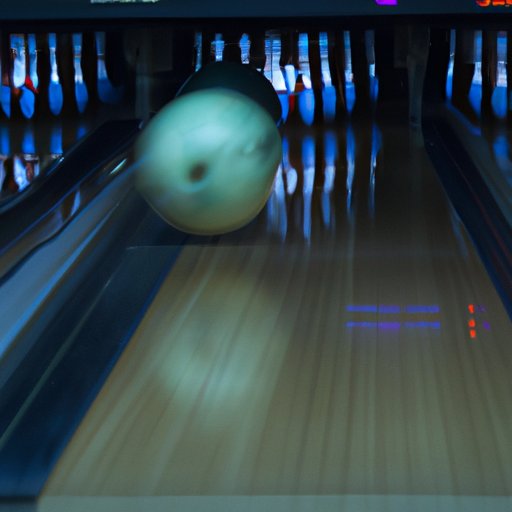
Introduction
Bowling is a sport that has been enjoyed for centuries, and while it can be a lot of fun, it’s also a game of skill. For serious bowlers, the ability to curve a bowling ball is an important aspect of the game that can give them a competitive edge. Curving a bowling ball can make it easier to hit certain pins and adjust to different lane conditions. In this guide, we will provide a step-by-step approach to curving a bowling ball, practical tips that you can use to refine your technique, and an exploration of the science behind it all.
Mastering the Art of Curving: A Step-by-Step Guide to Bowling Like a Pro
Curving a bowling ball involves making small tweaks to your form and release to create a more pronounced hook. The process can be broken down into several key steps:
- Choosing the right type of ball
- Establishing your starting position and footing
- Maintaining a consistent delivery
- Mastering the release
- Adjusting for lane conditions
Each step is important, and we will discuss them in more detail below.
Choosing The Right Type of Ball
It’s important to choose the right type of ball before you begin practicing your curve. Reactive resin balls are popular with bowlers because they have a high-friction surface that enables greater hook potential. They are suited for bowlers who throw a powerful shot. If you’re a beginner looking to develop your hook, a urethane or plastic ball may be more appropriate.
Establishing Your Starting Position and Footing
When curving a bowling ball, you need to establish a solid footing and starting position. Start by positioning yourself on the approach with your toes pointing towards the target. Your non-dominant foot should be positioned slightly ahead of the other and in the direction of where you want to aim. The dominant foot should be parallel to the non-dominant foot, and with your knees slightly bent, you can now begin working on your delivery.
Maintaining a Consistent Delivery
When curving a bowling ball, consistency is key. You need to develop a consistent delivery that involves a smooth swing, consistent release, and follow-through. The more you practice, the easier it will be to produce a consistent release. It’s also important to maintain a steady speed throughout the swing and deliver the ball with enough force to create a hook.
Mastering the Release
While curving a bowling ball, the release is perhaps the most critical element. The release should be smooth and fluid, with your fingers rolling the ball towards the target. As you release the ball, try to keep your hand in a relaxed and natural position – this should help impart more spin on your shot. You can adjust the angle of your wrist to change the amount of hook you produce.
Adjusting for Lane Conditions
The way you curve a bowling ball may need to be adjusted depending on the lane conditions. For oily lanes, you may need to adjust your hand position and angle of wrist release to produce a more gradual hook. For drier lanes, you may need to apply more hook to counteract the lack of oil on the lane surface. Experimentation is key.
5 Simple Tricks to Curve Your Bowling Ball Like a Pro
Along with following the step-by-step guide above, there are several practical tips you can follow to improve your curve:
- Relax your grip just before you release the ball
- Try using a four-step approach instead of five
- Visualize the ball’s path towards your target
- Pay attention to the ball’s rotation and hook, and adjust your delivery accordingly
- Work on increasing your ball speed to generate more hook potential
The Science of Curving a Bowling Ball: Understanding the Physics Behind it all
Curving a bowling ball isn’t just about using the right technique – it’s also about understanding the physics behind it all. Some key principles to keep in mind include:
- Friction: The friction between the ball and the lane surface determines how much hook you produce.
- Axis Rotation: The axis rotation of the ball refers to the amount of spin a ball produces when it’s delivered. If you increase the axis rotation, you will increase the amount of hook potential.
Curving a Bowling Ball: A Fun and Challenging Way to Improve Your Game
Curving a bowling ball may seem daunting, but it’s a fun and challenging way to improve your game. Curving allows you to adjust to different lane conditions, giving you greater control and accuracy. In addition, many bowling leagues and competitions require you to produce curved shots. View curving as a fun challenge and embrace the learning process!
The Do’s and Don’ts of Curving a Bowling Ball: Learn How to Avoid Common Mistakes
When learning to curve a bowling ball, it’s important to keep several do’s and don’ts in mind:
- Do practice regularly to build muscle memory.
- Don’t grip the ball too tightly
- Do use the right type of ball for the lane conditions
- Don’t force the ball/rush the release
- Do maintain a consistent bowling stance and form
- Don’t give up if you’re not successful right away! Curving a bowling ball takes practice and dedication.
Conclusion
Congratulations – you’re now well on your way to mastering the art of curving a bowling ball! Remember, consistent practice and a willingness to learn are key to improving your game. With these tips and techniques, you’ll be producing curved shots like a pro in no time.




